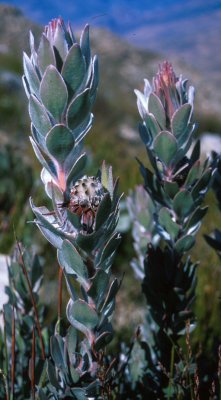
Home
Mission
Overview of Project
Project Staff
Sponsors
Achievements
Checking, Illustrations
Upcoming Activities
Id and Species Lists
Protea Information
Protea Gallery
Growing Proteas
Interim Dist. Maps
Publications
Afrikaanse Inligting
![]()
New Population of Gideonskop - Leucadendron bonum
| A new population of Gideonskop - Leucadendron bonum
has been discovered by Wendy Paisley, Pat Rebelo and David Osborne on Hondverbrand Peak in
the Cederberg. The population, totalling six plants, was found by David Osborne, Wendy
Paisley and Pat Rebelo on a Weekend Atlas trip to the eastern KoueBokkeveld. They were
following a lead, communicated by several people, that Hugh Taylor recalled seeing the
species on one of the peaks north of Gideonskop, while doing his botanical surveys in the
area. Up till now, Ld bonum has been one of the few proteas known from only a
single locality (Gideonskop). A herbarium specimen was not picked as the population was small and the plants were neither in fruit nor flower. We intend revisiting the site to obtain a herbarium record and hope to explore suitable sites at Breekkrans later this year in late spring. This increases the number of plants known to nearly 50 and the number of populations to two. The picture shown here was taken by David Osborne and was one of the plants in the new population at Hondverbrand. Tony Rebelo (April 2000) |
 |
Ld bonum and the demographic squeeze
The new population of Ld bonum at Hondverbrand (southern Cederberg) illustrates the problem of demographic stocasticity (see PAN 4:15).
Simply, with low population sizes, the chances of ending up with a single sex population becomes a statistical certainty. At Hondverbrand we have six females and no males. I presume that this is better than six males, because it is possible that some pollen may arrive from an unknown male nearby, or perhaps even from many kilometres away. As far as we know, females cannot set seed without pollen. Are these females living dead? Is this a viable population? Only time will tell.
Tony Rebelo